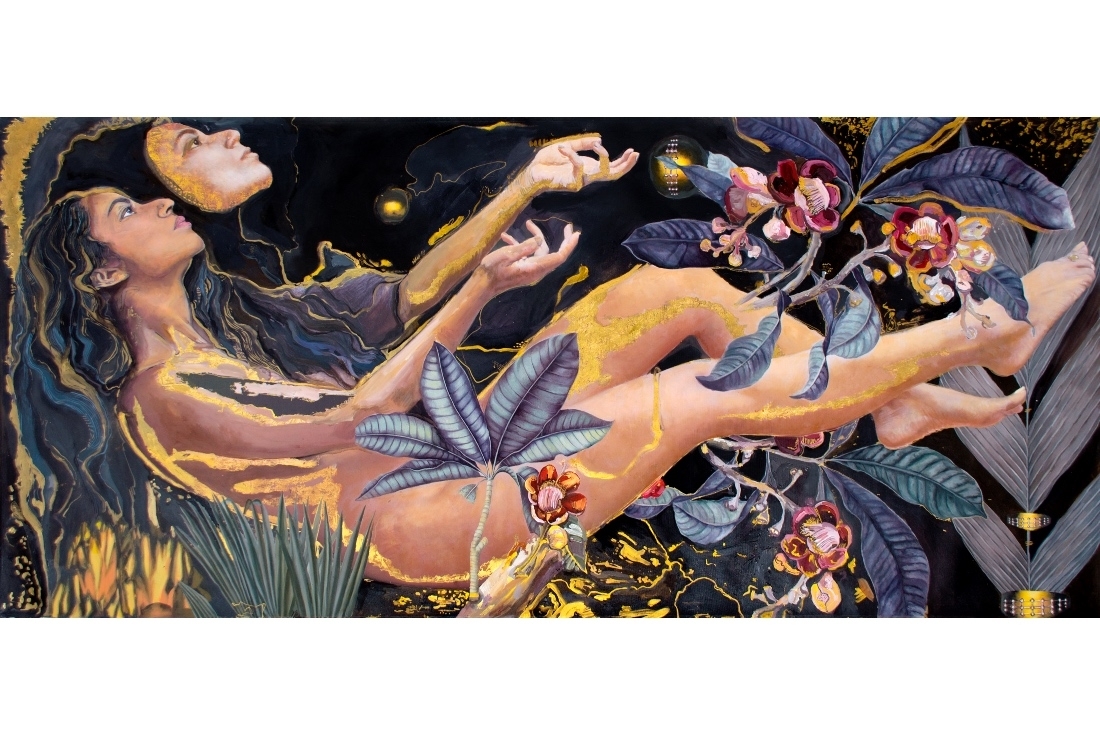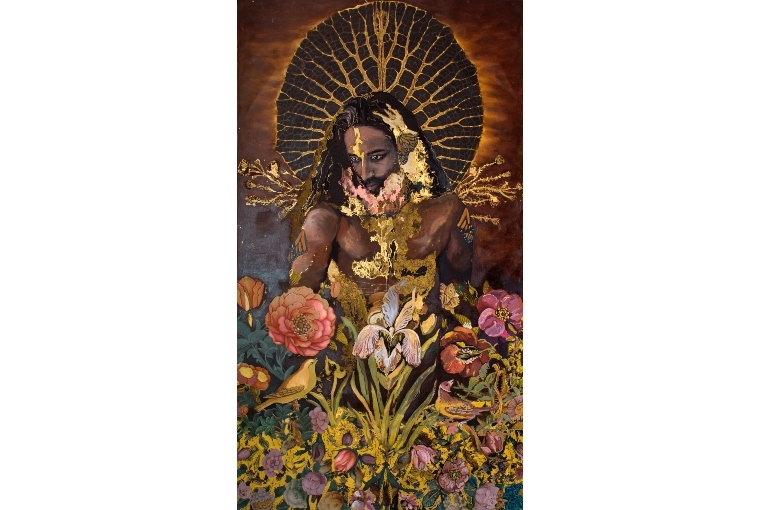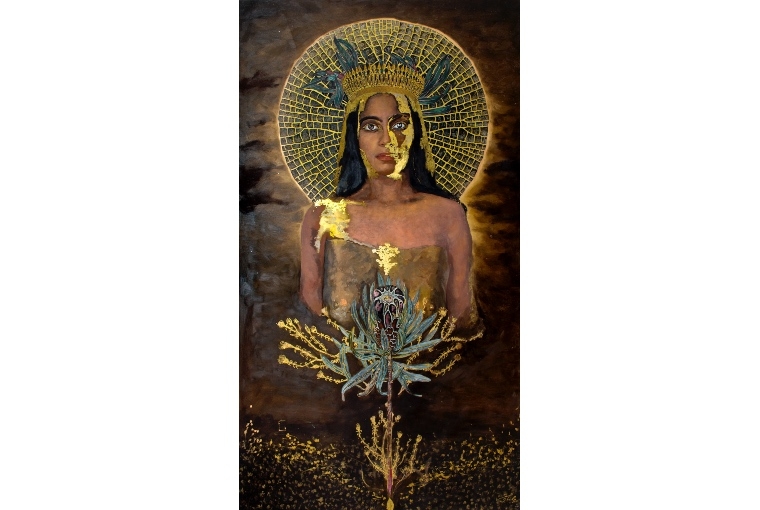
Shilo Shiv Suleman, Reincarnate, We Meet Here in the Afterlife, Acrylic on canvas, 32'' x 72â€, 2021

Shilo Shiv Suleman, Reincarnate, We Meet Here in the Afterlife, Acrylic on canvas, 32'' x 72â€, 2021
Shilo Shiv Suleman’s work is sustained by commitments to poetry, technology and social justice. She articulates her work across several platforms, including exhibitions, festivals and conferences, and now has even taken to the streets. Recently she started The Fearless Collective, a movement that aims to replace fear with love in the public space. She is adamant to give a voice to the people on the margins. For the Mumbai Gallery Weekend this year, Shilo has created a body of work that talks about reincarnation. We got in touch with her over a quick phone call to know more about the new show.
To begin with, what inspired your new show?
I believe we are not just reincarnating souls, but reincarnating stories. Perhaps the story of an Asura who returns as a virus that sweeps across the world, perhaps the story of Laila and Majnu who reincarnate through text messages and missed calls, perhaps in this lifetime, the lovers do not perish but reunite after the War and each time this story lives, it hopes to redeem itself and all of humanity. 2020 was about death and resurrection, but our worlds have ended so many times and begun again. Our myths and monuments are testament to the ever-living bodies that turn into gardens, civilisations that live beneath the shifting sands of empires, lovers’ tombs overgrown with ivy, flood myths and end of the world stories. Every incarnation is meant to serve a cosmic and not individual purpose. The purpose of an incarnation is said to be the reestablishment of dharma — righteousness, destruction of evil and protection of the good. Krishna says in the Gita, ‘Sambhavami Yuge Yuge’ (‘I will appear again and again to help humanity redeem itself’).
What medium of art have you used for this particular exhibition?
When I chose the word Reincarnate, it wasn't just about souls or stories. It was also about looking at traditional art practices within India and seeing how I could create art in collaboration with artisans from across Rajasthan in particular. So I worked with some incredible workers who do gold leafing and gold embossing. I also worked with an incredible brass sculptor, who made 21 pieces of my body with me in brass. So the mediums are everything, from clay, to brass to paint. I've put up a whole series of love letters, both imaginary and real. They are hand-painted with gold leaf onto the walls. In a place like India, where time is linear, sometimes if you go back into your past, you can re-emerge into your future. And even with the mediums, I am going back into the past so I can re-emerge into a new future.
What informs or inspires your work as an artist?
At the core of my work you'll find me in praise of beauty or defence of beauty. I try in many ways to embody/personify beauty as much as I can in how I speak and how I live in the world. The word Pooja literally just translates to an offering of beauty and so we have these traditional practices which would allow us five minutes a day just to offer beauty. And in my own life I often say that beauty saved me because art became emotional as well as financial backing for both me and my mother at a very difficult time in our lives. I was raised by her single handedly so the feminine also inspires me. Finally, love informs all my work.

Shilo Shiv Suleman, I return to Soil and Live Forever, Acrylic & oil on canvas, 62†x 35’’, 2021
What role do you think the art plays in our society today, especially with the backdrop of an ongoing pandemic?
I recently read an article which said that art is the least essential service according to 71% of India's population, which was funny to be honest because take away the art, take away the beauty, take away the poetry, take away the writing we did during that time and there would be very little left. On the other side of my practice, I also run a collective called The Fearless Collective in which we work with people on the margins to make their stories visible in public spaces. Art, beauty and being visible is also a form of being powerful. Our government spends 20000 crores in outdoor media and publicity every year, which to put into perspective is actually double of what we spent on ventilators during our biggest pandemic. So clearly being visible is important. Those who are visible are those who are powerful. Visibility is a currency of being powerful. Art is not an additive, it is essential. At the core of my movements like this, poetry is leading us into the new world. So I think a crisis like the pandemic is also about seeing the role art and creation plays in actually reclaiming the world we live in and the world we re-emerge into.
Do you think artists are not looking for validation from galleries anymore and are depending on social media more for their work to reach the masses?
For me, I have always been a social media baby. I've had an awkward blogspot, Twitter, Instagram, Facebook, et cetera. I have a big community of people on Instagram, who follow my work there and I'm very active and engaged. But at the same time, being well known on social media can be quite untethered. So showcasing your work physically in a gallery actually tethers me into a lineage. Like I'm tethered to Nilofer Suleman, Ragahava KK, Raza, and so that becomes my lineage, which I don't think happens if you're untethered and are an independent artist. I think that kind of ancestry for me has been very important and valuable.

Shilo Shiv Suleman, Tenacious Seeds, Acrylic & oil on canvas, 61†x 34’’, 2021